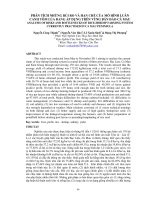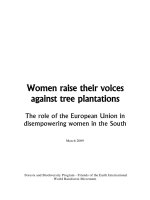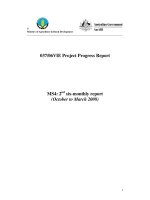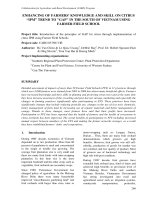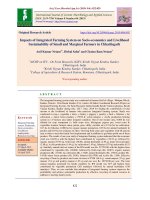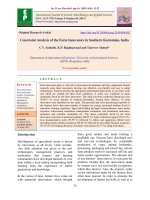Livelihood security through participations of tribal farm women in rice-based farming system in Bastar plateau of Chhattisgarh
Bạn đang xem bản rút gọn của tài liệu. Xem và tải ngay bản đầy đủ của tài liệu tại đây (243 KB, 7 trang )
Int.J.Curr.Microbiol.App.Sci (2020) 9(5): 1395-1401
International Journal of Current Microbiology and Applied Sciences
ISSN: 2319-7706 Volume 9 Number 5 (2020)
Journal homepage:
Original Research Article
/>
Livelihood Security through Participations of Tribal Farm Women
in Rice-Based Farming System in Bastar Plateau of Chhattisgarh
S.K. Painkra1, P.S.Netam2, S.P.Singh3* and G. R. Rathia4
1
College of Agriculture and Research Station, Raigarh (C.G.), India
2
SG CARS, Jagdalpur (C.G.), India
3
Krishi Vigyan Kendra, Raigarh-496001 (C.G.)
4
College of Agriculture & Research Station, Raigarh (C.G.).4
Indira Gandhi Krishi Viswavidyalaya, Raipur (C.G.), India
*Corresponding author
ABSTRACT
Keywords
Tribal livelihood,
Tribal farm women,
Empowerment,
Rice-based farming
system
Article Info
Accepted:
10 April 2020
Available Online:
10 May 2020
The study highlights the extent of tribal farm women’s actively participation through
various farm and household activities for livelihood security to their family life in rice
based farming system. A study was undertaken in Narayanpur district in Bastar plateau of
Chhattisgarh state to analyze the livelihood security through tribal farm women in rice
based farming system and identify different farm development activities. The
participations of tribal farm women in Narayanpur district mainly from rice cultivation,
horticulture and animal husbandry activities were taken for the study. The results further
revealed that the income may be generated through different farm activities by
enhancement in empowerment of farm women in rice based farming system. The data
showed that majority of the tribal farm women 56.66 per cent were actually involved in
rice transplanting under pre sowing activities 86.00 per cent in weeding and 95.33 per cent
drying and cleaning under intercultural, harvest and post harvest activities respectively as
well as Illiteracy was perceived as the top most constraints by 89.33 per cent respondent’s
empowerment through participation in farm activities for income generation for livelihood
security in rice –based farming system in the study area. For betterment of livelihood
security in their family life, basic facilities and requirements to be provided for raising the
employment and generating income through farm different developmental programmes
including household enterprises activities along with actively participation of tribal farm
women.
Introduction
It shows the study of history that it was the
tribal women who first domesticated crop
plants thereby initiated the arts and science of
farming
(Swaminathan,
1985).
The
involvement of tribal women, especially in
agriculture is an old age practice. Tribal
Farmwomen play a significant role in
agriculture along the side of their men folk
sharing the burden of farm works, care of
animals and poultry keeping in addition to
1395
Int.J.Curr.Microbiol.App.Sci (2020) 9(5): 1395-1401
their responsibilities along the side of their
men folk sharing under the household as
home maker. Enhancing women’s economic
status is an important strategy for improving
the welfare of entire the family. Socioeconomic upliftment and improvement of
livelihood condition of the people can be
directly linked with empowering rural women
for agricultural sustainability and efficient use
of available farm resources to make them self
sufficient in term of employment generation.
Narayanpur is known as primitive tribes’
district in India. Mariya and Muriya are main
tribes of the district. According to census
survey (2011), total population of the distrct
is 139820. In which more than 70 per cent
populations are come under tribal community.
Rice is cultivated as main crop and secondary
crop are maize, millets (Kodo, kutki, finger
and fox millets), oilseed and pulses under
raifed situations. Farmers do not adopt
advance agricultural technology in the
district. Due to which, production and
productivity is very low as compare to other
district of Chhattisgarh state. There Ricebased farming is productive enterprises to
generate of employment, family income,
utilize natural resources, and ensure food and
nutritional security in Narayanpur district in
Bastar plateau (Chhattisgarh). In this plateau,
agricultural is a main source of occupation
and the tribal farm women are actively
involved in several farm activities in rice based farming system for their livelihood
security. Thus, the importance role and
contribution of farm women to upliftment
their household in rice based farming system.
do not Therefore, extension services may
accordingly be turned to fully integrated them
for their enhancing productivity in rice
cultivation, so that their standard of living
pattern may be uplifted from below poverty
line. In this context a study was undertaken in
Narayanpur district Bastar plateau of
Chhattisgarh with the following objectives:
1.
To study the livelihood security and
involvement of tribal farm women in
different activities in rice based
farming system.
2. To identify the constraints in
empowerment of tribal farmwomen’s
in the study area.
Materials and Methods
The study was conducted in Narayanpur
block of Narayanpur district, Chhattisgarh. A
total of 150 tribal farm women as respondents
were selected from five selected village
panchayats viz., Bijli, Palki, Brehbeda,
Kudkajhore and Garhbengal through simple
random sampling methods. The data were
collected
through
personal
interview
techniques
with
pre-tested
interview
scheduled and analyzed for percentage and
mean score. Regarding the involvements of
tribal farm women different activities in rice
based farming, the response were recorded
from tribal farm women in 3-point scale i.e.
actively involved (2 scores), moderately
involved (1 score) and not involved (0
scores). The responses ranked on the basis of
mean scored were obtained.
Results and Discussion
In Narayanpur district (C.G.), the livelihood
pattern of tribal farm women in rice based
farming system mainly from rice cultivation,
horticulture and animal husbandry activities
were taken to the study. Therefore, it is very
important to know the involvement of tribal
women in these three activities for their
livelihood security. The relating to the
involvement the tribal farmwomen’s in rice
based farming system with respect to three
major
areas,
viz.,
agriculture
(rice
cultivation),
horticulture
(vegetable
cultivation) and animal husbandry (Dairy and
poultry) activities were taken at particular
study area.
1396
Int.J.Curr.Microbiol.App.Sci (2020) 9(5): 1395-1401
The data presented in Table 1. Participation of
respondents in rice cultivation was studied in
three selected sub-areas namely, pre sowing
and sowing activities, inter cultural activities
and harvest and post harvest activities. The
data revealed that majority of tribal women
(56.66%) were actively involved in
transplanting followed by manure application
and nursery raising i. e. 44.66% and 26.26%
respectively under Pre sowing & sowing
activities. This type of result was also
observed by Beohar et al., (1999), Hussain et
al., (2011), Kumari et al., (2016) and
Mohanta (2017). In case of inter cultural
activities, majority of respondent were
actively involved in weeding (86.00%) and
thinning & gap filling (80.00%) in rice
cultivation activities as well as in Harvest &
Post harvest activities greater percentages of
tribal farmwomen were engaged in operation
like drying & cleaning (95.33%), harvesting
(93.33%), winnowing (92.00%) and threshing
(23.33%), whereas, only 4.66 per cent
respondents were actively involved in treating
grains with insect repellants. Having showed
the data of this table, it may be reason behind
that the tribal women are more aware to their
house livelihood upliftment and it is possible
to participate in farming activities so that
income may be generated because agriculture
is main occupation of the study area. These
findings are in line with the findings of
Bhople and Patki (1992), Mohanty (1993),
Gopalappa (1997) and Das (1999).
The data with respect to horticultural
activities i. e. vegetable cultivation is
presented in Table 2. Shows that majority of
the tribal women were actively involved in
weeding (84.66%), Harvesting(80.66%),
Thinning & gap filling (75.33%), Uprooting
& transplanting (65.33%), Seed sowing &
watering the nursery (63.33%) Nursery bed
preparation (50.66%), Collection of vegetable
seeds (41.33%) whereas only (3.33%)
respondents actively involved in Preparation
of value added products in the study area. The
reason behind that the more participation of
tribal women in horticultural activities due to
maximum horticultural crops grown near at
house or farm as well as their cultural
habitation also. They know that it is the good
source of secondary income which may be
taken round the year from vegetables, where
irrigation facilities are available as well as
income is achieved earlier as compare to rice
cultivation. The tribal farm women belong to
low income group and income obtained from
small holding is insufficient for a reasonably
comfortable living. The poor involvement of
tribal farm women in preparation of value
added product might be due to illiteracy, lack
of awareness and exposure to different
training programmes. The same type of
findings was observed by Gidda Reddy
(2003).
The mean score and rank for involvement in
dairy activity presented in table 3 revealed
that the first four areas in which respondents
participated actively were care and
management of animals, Maintenance of
cattle shed, Fodder collection and Feeding of
animals with mean scores of 1.13, 1.08, 1.04
and 0.98 respectively. Only Marketing of
milk and Milking cow mean score was 0.16
and 0.08 with fifth and sixth ranks in the
study area. The rank was very low in case of
Milking of cow and Marketing of milk. On
the basis of observations like less use of milk
in family due to their cultural habitation as
well as unawareness about marketing of dairy.
The results supports the findings of Sharma et
al., (1989), Shashikala et al., (1990 and Jamal
(1994) and Chouhan (2009).
Majority of the tribal women under poultry
activities (42.66%) actively involved in
maintenance of birds cages followed by
Feeding of birds, Care and management of
birds and Selling eggs/birds i. e. (30.66%),
(30.00%) and (27.33%) respectively. The
1397
Int.J.Curr.Microbiol.App.Sci (2020) 9(5): 1395-1401
results shows that there is no more
management in case of poultry keeping and it
is possible along with housekeeping, which is
good source of income for household, which
may be easily adopted due to their cultural
habitant. The same types of findings was also
reported by Saikia et al., (1986) and
Waghmare and Chaudhari (1989).
The constraints in empowerment as perceived
by tribal farm women are furnished in Table
4. It was evident that Illiteracy was perceived
as the top most constraints as (89.33%)
respondents agreed with it as many as
(79.33%) respondents opined that lack of
practical knowledge as the second most
important hindrance in empowerment. The
other constraints perceived by the respondents
in order of importance were lack of exposure
to training programme (34.00%), male
dominancy in decision making activities
(48.66%), Problems of financial supports
(34.00%). Only (26.00%) respondents
expressed heavy works load due to duel
responsibility as one of the constraints in
empowerment for livelihood security in rice
based farming system. There was also found
literacy rate of very low, lack of awareness in
women education, low marriage of tribal girls
due to their socio cultural phenomena in the
society.
Table.1 Distribution of respondents on the basis of involvement in rice cultivation activities
Pre sowing & sowing
activities
Land preparation
Manure application
Seed selection and
treatment
Sowing of seed
Nursery raising
Transplanting
Intercultural activities
Weeding
Thinning & gap filling
Irrigation
Pesticide application
Fertilizer application
Harvest
&
Post
harvest activities
Harvesting
Threshing
Winnowing
Drying & cleaning
Treating grains with
insect repellants
Storing grains
AI
MI
NI
Rank
97 (64.66)
33 (22.00)
111 (74.00)
Mean
Score
0.43
1.22
0.36
11 (7.33)
67 (44.66)
15 (10.00)
42 (28.00)
50 (33.33)
24 (16.00)
16 (10.66)
40(26.26)
85 (56.66)
21 (14.00)
45 (30.00)
48 (28.66)
113 (75.33)
65(43.43)
17 (11.33)
0.35
0.83
1.45
VI
III
I
129 (86.00)
121(80.66)
10 (6.66)
00 (0.00)
09 (6.00)
15(10.00)
20 (13.33)
17 (11.33)
05 (3.33)
15 (10.00)
06 (4.00)
09 (6.00)
123 (82.00)
145 (96.66)
126(84.00)
1.82
1.74
0.24
0.03
0.22
I
II
III
V
IV
140 (93.33)
35 (23.33)
138 (92.00)
143 (95.33)
07 (4.66)
10 (6.66)
93 (62.00)
12 (8.00)
07 (4.66)
12 (8.00)
00 (0.00)
22 (14.66)
00 (0.00)
00 (0.00)
131 (87.33)
1.93
1.08
1.92
1.95
0.17
II
V
III
I
VI
128 (85.33)
10 (6.66)
12 (8.00)
1.77
IV
(Figures in the parentheses represent percentage)
AI= Actively Involved MI= Moderately Involved NI= Not Involved
1398
IV
II
V
Int.J.Curr.Microbiol.App.Sci (2020) 9(5): 1395-1401
Table.2 Distribution of respondents on the basis of involvement in horticultural (vegetable
cultivation) activities
Activities
Collection of vegetable seeds
AI
62
(41.33)
76
Nursery bed preparation
(50.66)
Seed sowing & watering the 95
(63.33)
nursery
98
Uprooting & transplanting
(65.33)
113
Thinning & gap filling
(75.33)
127
Weeding
(84.66)
121
Harvesting
(80.66)
Preparation of value added 05 (3.33)
products
MI
47 (31.33)
NI
41
(27.33)
Mean Score
1.14
Rank
VII
30(20.00)
1.21
VI
1.46
V
1.52
IV
1.65
III
15 (10.00)
44
(29.33)
26
(17.33)
20
(13.33)
15
(10.00)
08 (5.33)
1.79
I
18 (12.00)
11 (7.33)
1.73
II
15 (10.00)
130
(86.66)
0.16
VIII
29 (19.33)
32 (21.33)
22 (14.66)
(Figures in the parentheses represent percentage)
AI= Actively Involved MI= Moderately Involved NI= Not Involved
Table.3 Distribution of respondents on the basis of involvement in animal husbandry (dairy and
poultry) activities
Dairy Activities
Milking cow
AI
03(2.00)
MI
07 (4.66)
Feeding animals
Maintenance of cattle shed
Fodder collection
Care & management of
animals
Marketing of milk
53 (35.33)
69 (46.00)
61 (40.66)
69 (46.00)
42 (28.00)
24 (16.00)
35 (23.33)
32 (21.33)
07 (4.66)
Poultry Activities
Feeding of birds
Maintenance of birds cages
Care and management of
birds
Selling eggs/birds
NI
140
(93.33)
55 (36.66)
57 (38.00)
54 (36.00)
49 (32.66)
Mean Score
0.08
Rank
VI
0.98
1.08
1.04
1.13
IV
II
III
I
11 (7.33)
132
(88.00)
0.16
V
46 (30.66)
64 (42.66)
45 (30.00)
53 (35.33)
47 (31.33)
50 (33.33)
51 (34.00)
39 (26.00)
55 (36.66)
0.96
1.16
0.93
II
I
III
41 (27.33)
44 (29.33)
65 (43.33)
0.84
Iv
(Figures in the parentheses represent percentage)
AI= Actively Involved MI= Moderately Involved NI= Not Involved
1399
Int.J.Curr.Microbiol.App.Sci (2020) 9(5): 1395-1401
Table.4 Constraints perceived by tribal farmwomen for income generating activities in rice
based farming system
Constraints
Frequency
Illiteracy
Lack of practical knowledge
Lack of exposure to training programme
Problems of financial supports
Male dominancy in decision making
activities
Heavy works load due to duel
responsibility
134
119
94
51
73
percentage
89.33
79.33
62.66
34.00
48.66
Rank
I
II
III
V
IV
39
26.00
VI
(* The added percentage is more than 100 since multiple response were allowed)
Findings of the above study it was concluded
that the women participations is very
important in farm activities in rice based
cropping system to increase the employment
and income generation. For better standard of
living in their family life, improved crops and
livestock management technologies as well as
household activities, input and services,
awareness about training and education,
organized marketing and credit facilities is to
be provided by different line department like
agriculture, horticulture, veterinary and allied
sectors as well as it should be organized
training programme actively participation
with farm women in the field of agriculture
including household enterprises as well as
activities is to in proper time. so that the more
employment opportunities and income could
be generated by the tribal farm women to
their family.
References
Beohar, B. B., Sarawgi, A. K. and Chaudhary,
A. K. (1999). Women’s contribution in
paddy cultivation: A case study of
village of Chhattisgarh Region of
Madhya Pradesh. Indian J. of Agric.
Econ., 54 (3): 323-324.
Bhople, R. S. and Patki, A. (1992). Correlates
of role performance and training needs
of farm women labour. J. of Rural
Development, 11 (1): 49-58.
Chouhan, N. M. (2009) Participation of tribal
farm women in animal husbandry, paper
presented in: seminar on Participatory
approach in rural development on
August 31, 2009 at JAU, Junagarh,
Gujrat.
Das, L. (1999). A study on Multidimensional
Role in Farm and Home and Health
Status of Tribal Women in Kalahandi
District of Orissa. Ph. D. Thesis, BHU,
Varanasi.
Gidda Reddy P. (2003). Farming Performance
of farm women. Concept Publishing
Company, New Delhi.
Gopalappa,
D.V.
(2003).
Diversified
Agriculture and Rural Women. Yojana,
41 (11): 27-32.
Hussain, B., Hussain, N. A. and Yaseen, W.
M. (2011) An Empirical Analysis of
Women Participants in Farm Activities
in Rural Kashmir. Eur. J. Business
Manage. 3(5): 28-35.
Jamal, S. (1994). Women in dairy
development.
Cocept
Publishing
Company, New Delhi.
Kumari, A. R., meena, K. and Laxmikant
(2016) Role of Farm Women in Rice
Cultivation and Their Training Needs.
J. Krishi Vigyan., 5(1): 96-100.
Mohanta (2017) Participation of Tribal
Women in agriculture, International
1400
Int.J.Curr.Microbiol.App.Sci (2020) 9(5): 1395-1401
Journal of Science, Enviornment &
Technology, Vol. 6, No 1, 2017, pp.
745-750.
Mohanty, S. C. (1993) Social Position and
Property Rights of Kutia Kondh
Women. Adivasi, XXXIII (2): 16-20.
Saikia, P.D., Gogoi, K. and Lekharu, A.
(1986). Indian Rural Women, Mittal
Publications, New Delhi. pp.119-121.
Shashikala, S., Sundraswami, B. and
Shankramurthy, H.G. (1990). Activities
performance and Time Spent by Farm
Women of Rainfed and Irrigated Areas,
Indian Journal of Extension Education,
XXVI (3&4): 59-63.
Swaminathan, M.S. (1985). Imparting Rural
Women
Users’
Perspective
to
Agricultural
Research
and
Development. Report of the Project
Design Workshop on ‘Women in Rice
Farming System’, held at IRRI, Los
Banos, Philippines, April 10-13, pp. 14.
Waghmare, S.K. and Chaudhary N.V. (1989).
Tribal
women
in
agriculture,
Metropolitan Book Co. Pvt. Ltd., New
Delhi.
How to cite this article:
Painkra, S.K., P.S. Netam, S.P. Singh and Rathia, G.R. 2020. Livelihood Security through
Participations of Tribal Farm Women in Rice –Based Farming System in Bastar Plateau of
Chhattisgarh. Int.J.Curr.Microbiol.App.Sci. 9(05): 1395-1401.
doi: />
1401

